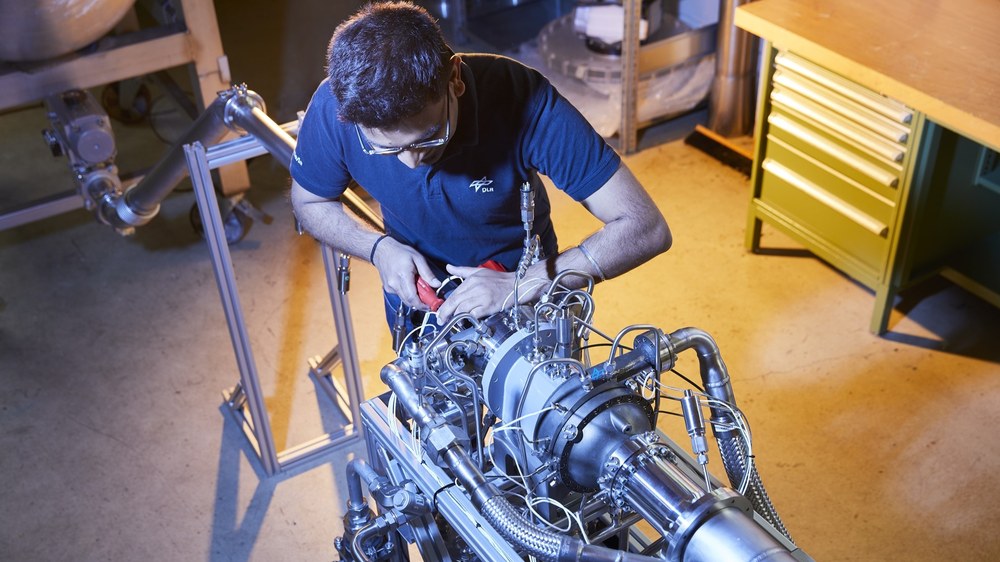Rocket engines: With turbopumps at the technical limit

- DLR has developed and tested a turbopump for rocket engines for the first time.
- Turbopumps are among the most important components of a rocket engine – they generate the necessary pressure in the combustion chamber and deliver the propellants to the injection head of the combustion chamber.
- The tests focused on the successful commissioning and performance of the turbopump.
- DLR has a unique test facility portfolio and comprehensive know-how for tests with components and complete systems.
- Focus: Space flight, technology development
Moving fuels from the tanks to the combustion chamber, and doing so under high pressure, is the essential challenge for a turbopump. For the first time in Germany, the German Aerospace Center (DLR) has developed, built and tested a turbopump for both oxygen and methane at its Lampoldshausen site. The turbopumps are to be used in the LUMEN technology demonstrator. With this demonstrator engine, the DLR development team is pursuing the ambitious goal of expanding its expertise from the research and development of engine components to the overall system of a complete rocket engine. In particular, control using artificial intelligence methods will play an essential role in significantly improving the application range of the high-performance engines.
Probing the limits of a turbopump
The turbopump consists of a single-stage pump for pumping oxygen and a single-stage supersonic turbine, which is driven in the engine with hot methane. The hot methane is directed supersonically onto the turbine rotor to maximize power output. DLR engineers tested the specially developed oxygen turbopump for the first time in August 2021 on the P6.2 test facility. The media water and nitrogen were used to initially test all parts for functionality and to be able to guarantee safe operation. The turbopump achieved a maximum operating time of 150 seconds at 25,000 revolutions per minute (rpm). A pressure of 80 bar was reached at the pump outlet. "We also checked the cavitation properties of the turbopump," said Tobias Traudt, project manager at the Institute of Space Propulsion, explaining further: "Cavitation occurs at the pump inlet when the inlet pressure is too low and vapour bubbles form in the flow as a result. The vapour bubbles can lead to vibrations and damage the pump blades."

Rocket engines: With turbopumps at the technical limit
Your consent to the storage of data ('cookies') is required for the playback of this video on Quickchannel.com. You can view and change your current data storage settings at any time under privacy.
Turbopumps for launch vehicles that are to reach orbit must be built as compactly as possible with an extremely high energy density. To achieve this, they run at the highest speeds of several tens of thousands of revolutions per minute and usually generate over 100 bar in a single pump stage. Turbopumps for first-stage applications are about the size of a car engine, but instead of 200 horsepower they have an output of 7,000 horsepower and more. Turbopumps are designed at the technical limit and must weigh as little as possible. These requirements mean that turbopumps have an approximate maximum service life of only one hour.
The next step is to use it in the LUMEN demonstrator
"Alongside the combustion chamber, the two turbopumps are the most important components in the DLR LUMEN project. The turbopumps generate the necessary pressure to operate the combustion chamber by delivering liquid oxygen and liquid methane to the injection head. Both turbopumps are driven by methane gas, which was used for cooling in the LUMEN combustion chamber," says Dr. Jan Deeken, head of the Rocket Propulsion Systems department at the Institute of Space Propulsion. The DLR project LUMEN will design, manufacture and operate a demonstrator for a cryogenic upper stage engine. This will make it possible to investigate the special problems arising from the coupled operation of the individual components. The demonstrator's design, which is optimised for test facility operation, also ensures good metrological accessibility to all individual components. The data obtained in this way provide a much more detailed insight into the operating behaviour of an engine than is possible on real aircraft engines.
Contact
Tobias Traudt
